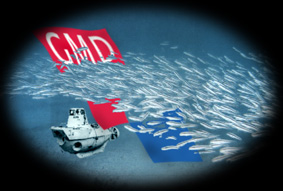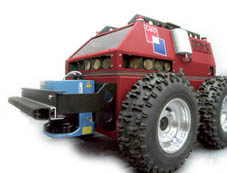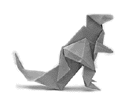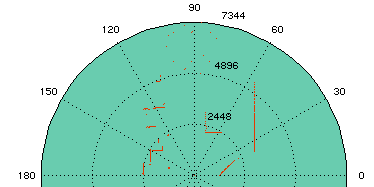
Research
Publications
Events
People
Partners
Resources
Jobs
Contact
Citations










 
 

















Ricerca
Pubblicazioni
Eventi
Personale
Collaborazioni
Risorse
Offerte d'impiego
Come contattarci
Citazioni
Recherche
Publications
Manifestations
Collaborateurs
Partenaires
Ressources
Avis de vacance
Adresse de contact
Citation
Forschung
Veröffentlichungen
Veranstaltungen
Mitarbeiter
Partner
Resourcen
Stellen-
 ausschreibungen ausschreibungen
Kontaktadresse
Zitate
|
 Index of this page Index of this page
Research objectives
GMD is confronting the autonomous systems ideas, methods and technologies, which are tested mostly on land-vehicles with the harsh as well as fruitful underwater world. The request for autonomy is obvious here, and the environment is by all means dynamic and open. Thus the underwater scenario is also regarded as one of the best environments for autonomous systems approaches.
Applications of really autonomous underwater vehicles are wide spread and a couple of them are either of great enivronmental or economic importance. Global climate prediction, deep sea exploration, ocean cable inspection, searching for resources, earthquake prediction, and understanding life in remote areas are some of the major applications that could be identified.
The research is concentrated on the system identification in underwater scenarios based on the following assumptions:
- Open systems – autonomous robust systems considered here are operating in open environments, i.e. environments which are not under full control of the system designer. Technically speaking, the interpretation of sensing and senor-actuator coupling can not be pre-designed completely, and needs to be adjusted or reorganized during the systems lifetime.
- Complete robots – most components defining a robot operating in open environments matter; including morphology, sensors, actuators, internal structures, states, kinematics and dynamics – all components are strictly interdependent and will thus not be considered independently. This implies that the building blocks in tackled scenarios are complete robots.
- Dynamics – interactions in open environments can neither be formulated, nor designed, or analyzed fully using stationary or static models. This touches especially criticisms about the finite automata theory, but also models of asynchronous, parallel, or even analogous processing. The theoretical basis for dynamical systems beyond the terms of attractors of different complexity is very weak still. Nevertheless dynamics are identified as a central aspect and will be attacked and employed wherever possible.
- Adaptivity – as a direct result of the open environments assumption above, a robot needs to come up with generic parts and/or adaptive behaviours.
- Simplicity – robust solutions are simple. This pragmatic and in itself simple sounding insight needs to be taken seriously in a research field, where the whole systems are usually out of the range of analytical methods and engineerical designs. Instantiations of approaches centered on simple solutions for complex tasks can be found in [1] or [2].
Research threads
Research is driven by well defined and thrilling questions. Thus this section is opened with some of the most important questions that are attacked in GMD – Japan Research Laboratory.
What kind of spatial models are adequate in open environments?
Independent from the actual task (exploration, search, manipulation, etc.) the spatial models identified in biological species differ significantly from most technical ones (see study ‘BioInformation’ (sorry, in German) 3/99 for the German ministry for science and education 'bmbf'). Coupled with the technical need to investigate in open environments, this field of research is at the edge of current knowledge as well as stuck with practical implications (discussed below).
How to achieve task-driven sensor data processing and information extraction on real world data?
This traditional main stream of sensor data’ interpretation’ is widened by ‘sub-symbolic’ or ‘bottom-up’ sensor data processing strategies since at least two decades now. A couple of technical methods have been developed already (like e.g. Independent Component Analysis [3]) pushing the solution of long-term technical problems significantly (like blind source separation – the ‘cocktail-party’ problem).
Attacking the above questions in the underwater environment, means to accept an extensive phase of experiments and to view a wide range of applications as well as challenges.
The kind of architectures focused here are staked out by the works in [4][5][2][6][7][8] and [9]. Nevertheless the research field is anything but settled. Since it is assumed that robot architectures depend strictly on the actual setup, it is not tried to reduce to the ultimate architecture. Instead, implemented architectures are based on the experiences and theoretical foundations of current state of the art models as well as on the constraints and possibilities of the setup.
Complex signal -processing, -abstraction, or -interpretation is a general task appearing in different parts and components. Due to open environments, most appearing signals are complex and need sophisticated, while generic and adaptive processing techniques. Signals are considered as detected from different sensor modalities, focusing on tactile interaction, sensing of (self-) movement in multiple ways, and audition (see e.g. ). Three recent methods will be mentioned in the following. Of course the laboratory is not limited to these methods – but some important ideas are indicated here.
Conclusion
Summarizing the objectives of the laboratory the author would like to conclude in keywords first:
- Theoretical foundation and physical experiments
- ‘Bottom-up’ sensor data processing
- Complete (physical) systems / architectures
It is assumed that the combination between the above research motivations and the underwater world brings up new ideas which are pushing ...
- ... hard scientific experimental setups,
- ... signalprocessing and architectural issues,
- ... underwater applications and applications in other 'real' and open environments,
- ... and finally some global problems, like global environmental issues.
-
 Until actual underwater experiments are being set up, we are employing land robots for preliminary test (like the one on the picture on the right). Until actual underwater experiments are being set up, we are employing land robots for preliminary test (like the one on the picture on the right).
-
- Please feel invited to send us any ideas or comments, or even just to enjoy the rest of this site.
-
-
figure 2: this diagram gives an impression what the land robots are usually sensing in their laboratory environment (here the output from the laser range finder: top view of an 180° range scan - most other sensors on the robots do not allow for such obvious visualizations)
-
-
figure 3: the above animation shows the time course of the internal range model during a testrun in a small room. The model is fixed in relation to the robot. Note that only a sector in front of the robot is continuously scanned by the laser range finder, and the remaining areas of the model are 'washed out' after a while (a person is crossing the scene at a certain time - perhaps you can figure out when ...).
During the whole testrun, the robot was performing completely autonomously, and was controlling the motors based on this 'on the fly' constructed model only. The maximum speed was limited to 80 cm/s, since the heavy vehicle was forced to approach some obstacles up to as close as 10 cm (the vehicle itself [100 * 65 cm] is not shown in the animation).
(total size: approx. 250 gif-frames)
-
References
[1] Cruse, H.; Bartling, Ch.; Dreifert, M.; Schmitz, J.; Brunn, D.E.; Dean, J., T. Kindermann
Walking: A complex behaviour controlled by simple networks
Adaptive Behaviour Vol. 3, No. 4, 385-418, MIT Press, 1995
[2] Lambrinos, Dimitrios; Kobayashi, Hiroshi; Pfeifer, Rolf; Maris, Marinus; Labhart, Thomas; Wehner, Rüdiger
An Autonomous Agent Navigating with a Polarized Light Compass
Adaptive Behaviour Vol. 6, No. 1, pp. 131-161
[3] Lee T-W., Girolami M., Bell A.J., Sejnowski T.J.
A unifying information-theoretic framework for independent component analysis
International journal on Mathematics and computer modelling, in press
[4] Gat, Erann
Integrating Planning and Reacting in a Heterogeneous Asynchronous Architecture for Real-World Mobile Robots
In Proceedings of the AAAI '92, San Mateo, CA 1992. Morgan Kaufmann
[5] Hertzberg, Joachim; Jaeger, Herbert; Zimmer, Uwe R.; Morignot, Philippe
A Framework for Plan Execution in Behaviour-based robots
Proc. of the ISIC/CIRA/ISAS '98, September 14-17, 1998, Gaithersburg, Maryland, USA
[6] Prescott, Tony J.
Spatial Learning and Representation in Animats
The Proceedings of the Third International Conference on Simulation od Adaptive Behaviour, Brighton UK, August 1994, pp. 164-173
[7] Schaal, S.; Sternad, D.; Atkeson, C. G.
One-handed juggling: A dynamical approach to a rhythmic movement task
Journal of Motor Behavior, 28, 2, pp.165-183
[8] Tani, Jun; Nolfi, Stefano
Self-organization of modules and their hierarchy in robot learning problems: a dynamical systems approach
Technical report SCSL-TR-97-008 - Sony CSL, Tokyo, Japan
[9] Zimmer, Uwe R.
Autonomous underwater vehicles – a perspective for research and application –
German National Research Centre for Information Technology (GMD), Schloß Birlinghoven, 53754 St. Augustin, Germany – Technical report, 1998


Search our site and sourroundings  daily (down now) daily (down now)
... and perhaps our European mirror is more convenient for you (outdated)
Last site update: Thursday, January 10, 2002 (contact editors)

|





